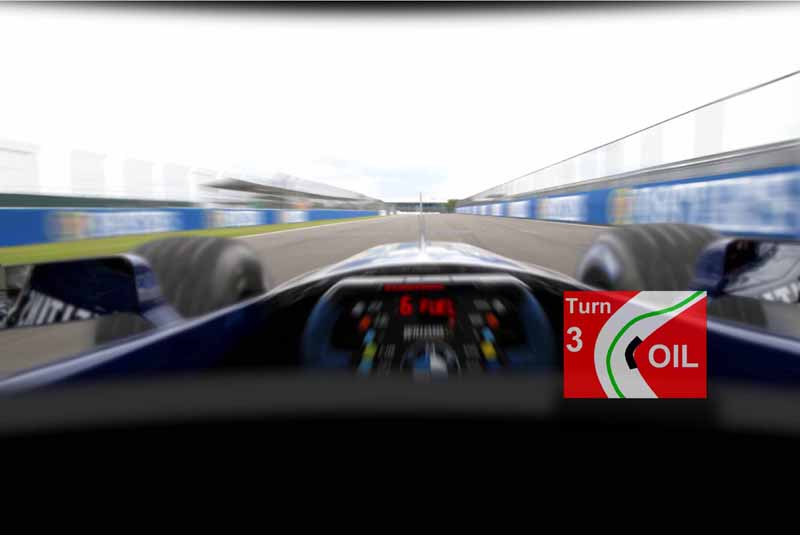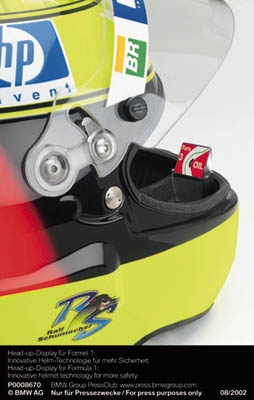Heads up displays
Projecting information directly into a driver’s line of sight allows them to process it up to 50 times faster than normal. This is due mainly to the shorter eye movement required and the fact that their attention can remain focused on the road ahead. Such technology features in everyday life for some drivers, as it is currently available in some Audi, BMW and Mazda models, for example. With market research predicting that 9% of all new roadcars will feature a HUD (heads-up display) system by 2020, an obvious question is why has this technology not been adopted by Formula One? Well, the answer is, it has.
Originally designed for military pilots in the mid-1950s, HUDs expanded into commercial aviation in the 1970s, and the late 1980s saw the first production car with a fully integrated HUD. The technology then found its way into Formula One in the early 1990s with Team Lotus, which used a Frazer Nash system where a tiny projector and half-mirrored glass panel were fitted to the inside of the driver’s helmet in front of one eye. It could display information such as rpm warning lights and gear position, but the drivers did not warm to the system because of safety concerns about having hardware in front of their faces; they also seemed to find the system distracting.
The next and so far last time HUDs featured in Formula One was in the 2003 season, when the BMW Williams F1 team developed a system for Ralph Schumacher, and his third place in Hungary marked the first and only time a HUD has been used in race. Specifically designed for Schumacher’s eyesight, the 6 x 8 mm display was integrated into the chin cup of his helmet, and the system worked by storing messages and images in a dataset that could be called up from the pits and then displayed to him by projecting a ‘transparent’ image through his visor.
The display was high-resolution true colour, based on the active matrix liquid crystal display (AMLCD) technology, a type of flat panel display commonly used in mobile phones and televisions these days. The ‘active matrix’ refers to the thin-film transistors and capacitors in the display of the screen that control each individual pixel, resulting in quicker response times and a clearer picture, as opposed to a ‘passive’ matrix that has to alter a full row of pixels to modify a single pixel, and is therefore slower. The active matrix ensures that the system is brighter, more colourful and capable of dealing with faster moving images, and a unique lens element called a free form prism is used to make the picture sharp.
The display was located in the peripheral vision field of Schumacher’s dominant eye, making it easier for him to see, without having to look at the display directly. This offers an advantage over the current display on the steering wheel because when a driver looks at the steering wheel, the horizon becomes unfocused, whereas when the driver focuses on the track ahead, the display remains in focus. Furthermore, unlike the screen on the steering wheel, which rotates with every steering input, the HUD only moves with the driver’s helmet. It also enables the driver to choose when he wants to receive the information, for example when it is safe or on a straight, unlike with radio communications from the pits.
Regarding recent events at the Japanese GP in Suzuka and the reduced radio rules, HUDs may offer an alternative to the steering wheel display. From a safety point of view, critical information such as track status and yellow zones can could be displayed constantly in the driver’s peripheral vision, which arguably is less distracting. Also, as the HUD display can be slightly larger than the display on the steering wheel, the size of the steering wheel can be reduced, which in essence is what delayed the radio rule change until 2015.
Schumacher’s feedback in 2003 was positive, although the system was banned by the FIA because of the safety implications of having the display mounted inside the helmet. One chief technical officer said that, although they are effective, HUDs will only work in Formula One if the focus point is at infinity, to avoid the driver having to refocus, and if the safety of the system is developed further.

 Figs. 1 and 2 - The system developed by BMW Williams in 2003 specifically for Ralph Schumacher’s eyesight. A variety of information was displayed to him, and this may be a way of communicating yellow flagged zones and the car’s status without using radio. However, the safety aspect of having the display so close to a driver’s face remains an issue
Figs. 1 and 2 - The system developed by BMW Williams in 2003 specifically for Ralph Schumacher’s eyesight. A variety of information was displayed to him, and this may be a way of communicating yellow flagged zones and the car’s status without using radio. However, the safety aspect of having the display so close to a driver’s face remains an issue
Written by Gemma Hatton